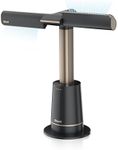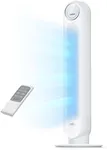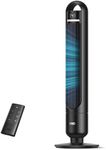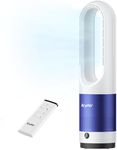Buying Guide for the Best Bladeless Fans
Bladeless fans are a modern and innovative way to keep your space cool. Unlike traditional fans, they use air multiplier technology to create a smooth and consistent airflow without visible blades. This makes them safer, quieter, and often more energy-efficient. When choosing a bladeless fan, it's important to consider several key specifications to ensure you get the best fit for your needs. Here are the main specs to look at and how to navigate them.AirflowAirflow is the amount of air the fan can move, usually measured in cubic feet per minute (CFM). This spec is important because it determines how effectively the fan can cool a room. Higher CFM values mean more powerful airflow. For small rooms or personal use, a lower CFM (around 100-300) might be sufficient. For larger rooms or more intense cooling, look for higher CFM values (500+). Consider your room size and how much cooling you need to choose the right airflow.
Noise LevelNoise level, measured in decibels (dB), indicates how loud the fan will be during operation. This is important for ensuring a comfortable environment, especially if you plan to use the fan in a bedroom or office. Lower dB values mean quieter operation. Fans with noise levels below 40 dB are considered very quiet, while those above 60 dB might be too loud for some settings. Think about where you'll use the fan and how sensitive you are to noise when selecting the right noise level.
OscillationOscillation refers to the fan's ability to rotate and distribute air across a wider area. This feature is important for evenly cooling a room. Some fans offer a fixed position, while others can oscillate up to 360 degrees. If you need to cool a larger space or want more even air distribution, look for a fan with a wide oscillation range. For targeted cooling, a fixed or limited oscillation might be sufficient.
Speed SettingsSpeed settings allow you to adjust the fan's airflow intensity. This is important for customizing your comfort level. Fans typically offer multiple speed settings, ranging from low to high. More speed settings provide greater flexibility in adjusting the airflow to your preference. If you like having precise control over the cooling effect, choose a fan with several speed options. For simpler needs, a fan with just a few settings might be adequate.
Remote ControlA remote control allows you to operate the fan from a distance, adding convenience. This feature is particularly useful if you plan to place the fan in a hard-to-reach spot or want to adjust settings without getting up. Some fans also offer app control via smartphones. If convenience and ease of use are important to you, look for a fan with a remote control or app compatibility. If you don't mind manual adjustments, this feature might be less critical.
Timer FunctionA timer function lets you set the fan to turn off after a certain period, which can help save energy and provide convenience. This is useful if you want the fan to run while you fall asleep or during specific times of the day. Timers can range from 1-hour to 8-hour settings or more. If you like the idea of automatic shut-off, choose a fan with a timer function that suits your schedule. If you prefer to control the fan manually, this feature might not be necessary.
Air PurificationSome bladeless fans come with built-in air purifiers, which can help remove allergens, dust, and other particles from the air. This is important for improving air quality, especially if you have allergies or respiratory issues. Look for fans with HEPA filters or other purification technologies if air quality is a concern. If you only need cooling and don't have air quality issues, a fan without this feature might be sufficient.










